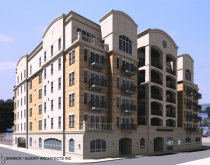METHODS OF COMPENSATION
Standard forms of agreement are available from the American Institute of Architects (AIA) for the customary methods of compensation for the Architect’s services. The four basic methods of compensation found in the agreements are outlined below:
1.1 Percentage of project construction cost. With this method, compensation for Basic services is based on a percentage of the construction cost of a project. For additional services, the Architect’s compensation is based on a multiple of the direct personnel expense of his staff working on the project and a multiple of the actual cost of the services of consultants for structural, mechanical, and electrical engineering work. The project construction cost is defined and discussed later in this statement of the Architect’s services. For the purpose of computing the Architect’s compensation, it does not include reimbursable expenses (long-distance telephone charges, transportation or living expenses, building permits, etc.), compensation of the architect or his consultants, cost of land, rights-of-way, or other costs not related to actual construction.
1.2 Multiple of Direct Personnel Expense.This method of compensation traditionally has been used on projects where the scope could not be defined and on projects without a fixed construction budget. The Multiple of Direct Personnel Expense is becoming more popular for all types of projects because of complete services, since no distinction need be made between Basic and Additional Services. The Architect’s compensation is added on the amount of time required for his services on the project. For owners who request that a specific amount be stated for the Architect’s compensation, this form of agreement may be used with and upset limit, not to be exceeded without authorization. In such cases, it is important to specify what services will be included for the stipulate maximum amount. Under the terms of this type of agreement, the Architect is paid the payroll cost of technical personnel working on the project increased by and amount to cover his indirect expenses, overhead and profit. Reimbursable expenses are paid to the Architect for those items specifically listed in the agreement.
1.3 Professional Fee Plus. This method of compensation establishes a fixed sum over and above reimbursement for the Architect’s technical time and overhead. An agreement on the general scope of the work is necessary in order to set an equitable fee.
1.4 Per Diem or Hourly Rates. This method of compensation is applicable in all practical cases. Payment is due upon presentation of the Architect’s invoices. These normally will be tendered at the completion of the services if performed in a reasonable length or time, or monthly if the services extend over a longer period. For Clients who request that a specific amount be stated for the Architect’s compensation this form of agreement may also be used with an upset limit, not to be exceeded with out authorization. The Architect also in this final case is paid the payroll cost of technical personnel working on the project, increased by and amount which covers his indirect expenses, overhead and profit. Consultant expenses and reimbursable expenses are paid the same.
FEE STRUCTURE FOR BUILDING GROUP TYPES
The separation of buildings into types is for the purpose of indication their relative complexity and their resulting demand of the time, skill, creative ability and professional knowledge of the Architect, his staff, and consultants.
Professional services required for different types and sizes of buildings may vary widely. Basically, the amount of work measured in man-hours and in types of personnel required to render professional services determines the amount of compensation an professional services determines the amount of compensation an Architect should receive. A small building ordinarily will require more time per unit of volume than will a larger building of the same type. Restorations, rehabilitations, alterations, and additions invariably require more work and thus warrant an increase in the Architect’s compensation above that for new buildings of comparable construction cost. Highly specialized building types and specialized services such as landscaping, selection of furnishings and equipment, store- fronts, and interior design command higher compensation.
When the services of the Architect are required in the design of a structure or structures composed of repetitive units, the Architect’s compensation should be negotiated between the Architect and Owner, recognizing that the compensation should be proportionate to the services to be rendered. The amount of compensation also should reflect the increased responsibilities assumed by the Architect because of the repetitive nature of the project.
When the project combines facilities in more than one type, the Architect’s compensation should be determined by a proportionate combination of the appropriate categories.
The basic rates are based on complete architectural and engineering services, including normal structural, plumbing, HVAC, and electrical work.
Should the execution of any work designed or specified by the Architect, or any part of such work, be abandoned or suspended, the Architect is to be paid in accordance with or in proportion to the terms and payments set forth in the Owner-Architect Agreement, and up to the time of such abandonment or suspension.
ARCHITECTURAL BASIC SERVICES FEE MATRIX
(Fee matrix provided upon Request).











